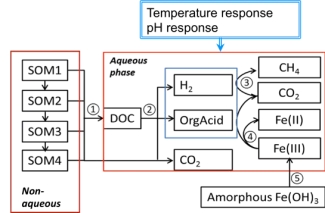Rapid warming of Arctic ecosystems accelerates soil organic carbon decomposition, leading to increased emissions of carbon dioxide (CO2) and methane (CH4) that have a positive feedback on global warming. Accurate prediction of carbon emissions from permafrost requires a more versatile carbon decomposition model framework that can be applied to soils under varying redox conditions. We built a new carbon decomposition model with a defined aqueous phase to facilitate thermodynamic calculation and dynamic redox reaction-pH simulation. This new model framework was parameterized and validated using synthesized anaerobic incubation data from permafrost-affected soils along a gradient of fine-scale thermal and hydrological variabilities across Arctic polygonal tundra. The model accurately simulated anaerobic CO2 production and its temperature sensitivity using data on labile carbon pools and fermentation rates as model constraints. Modeling and synthesis results demonstrate that CH4 production is strongly influenced by water content, pH, methanogen biomass, and presence of competing electron acceptors, resulting in high variability in temperature sensitivity. This work provides new insights into the interactions of soil organic matter pools, temperature increase, soil geochemical feedbacks, and resulting CO2 and CH4 production. Our proposed anaerobic carbon decomposition framework builds a mechanistic link between soil geochemistry and carbon mineralization, making it applicable over a wide range of soils under different environmental settings.
For more information, please contact:
Jianqiu Zheng
zhengj@ornl.govDavid Graham
grahamde@ornl.gov

